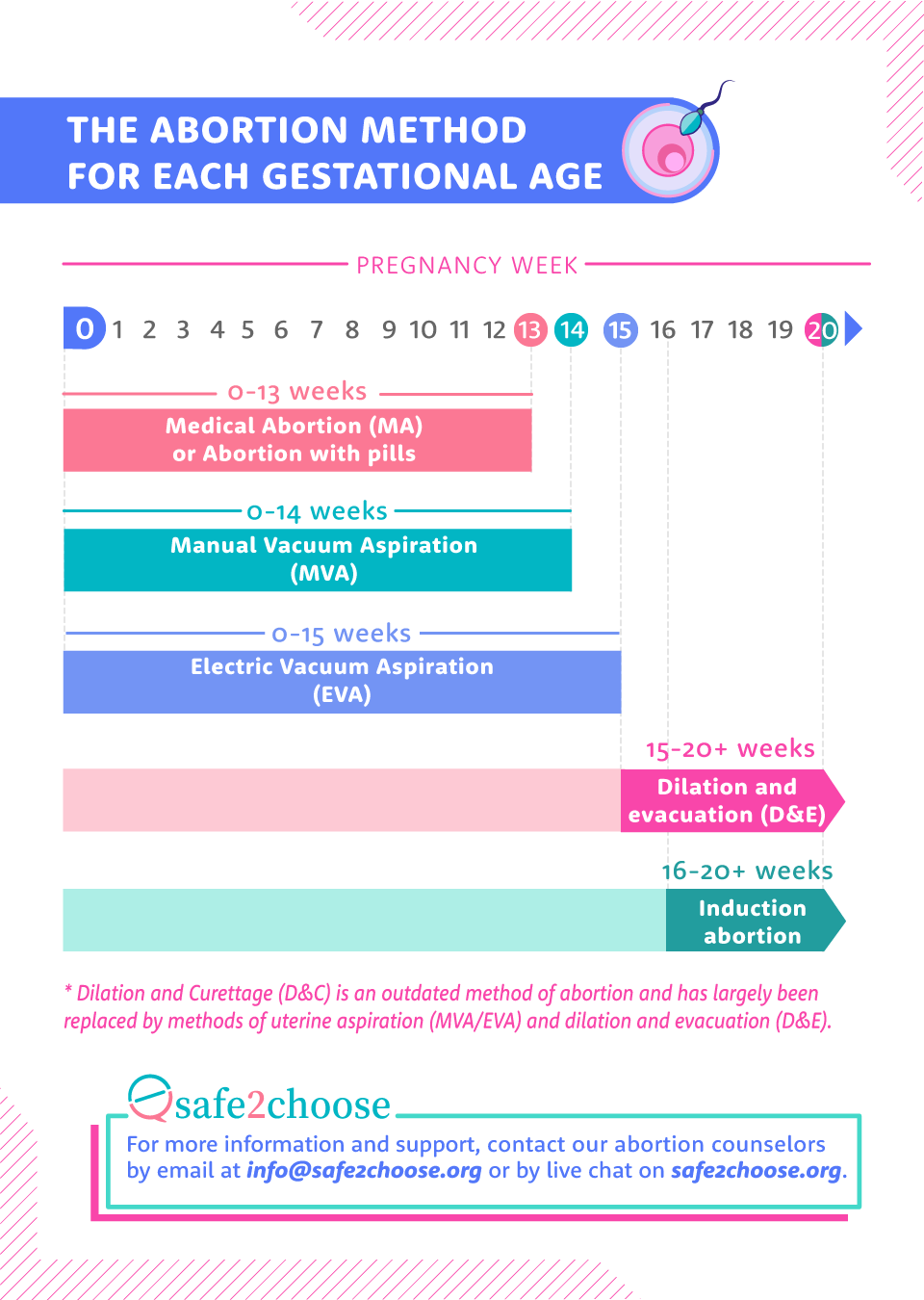How do you calculate the number of weeks of pregnancy?
Calculating your time of pregnancy is important regardless if you decide to terminate or continue the pregnancy.
If you decide to end the pregnancy, the weeks of gestation will help determine which options of abortion methods are available for you.
If you decide to continue the pregnancy, this will help your midwife or doctor know if the pregnancy is evolving normally. Keep in mind that a pregnancy usually lasts around 38 to 42 weeks from the first day of your last menstrual period. [1]
The easiest way to calculate the weeks of your pregnancy is by counting the number of weeks and days from the first day of your last menstrual period.
It is important to count from the first day of your most recent menstrual period, because from this we can estimate when the egg was released and fertilized [2]
Be careful with some of the common mistakes, do NOT calculate by:
– counting from when you missed your period;
– counting from the day of sexual intercourse;
– counting from the day you think you became pregnant.
If you need help calculating the weeks of your pregnancy, select the first day of your last menstrual period here.
Pregnancy Calculator
Select first day of your last menstrual period:
If you do not keep track of your period or you cannot remember the last time you had it, think back to what you were doing when you last got it. Where were you? Who were you with? This sometimes helps you remember the date when your last period occurred. [3]
The other tests to confirm a pregnancy
1) Urine test: This test is very common, and it detects the presence of pregnancy hormones in the urine. In order to avoid a “false negative” this test should be done 2 weeks or more after unprotected sex.
– Benefits: It is inexpensive and can be done privately at home.
– Disadvantages: It does not help calculate the age of the pregnancy.
2) Blood test: Two types of this blood test exist: qualitative (detects the pregnancy hormone hCG in the blood) and quantitative (measures the amount of hormone).
– Benefits: It can detect earlier pregnancy than the urine test, and can sometimes help determine the approximate age of the pregnancy (if quantitative).
– Disadvantages: It is more expensive, and must be ordered by a health provider.
3) Ultrasound: This test is useful after at least 4 weeks of pregnancy or more, otherwise nothing will be seen. It can be particularly helpful if you do not know your last menstrual period.
– Benefits: It is very accurate to estimate the gestational age, and can also be used to identify ectopic pregnancy or other non-viable pregnancies.
– Disadvantages: It can be very expensive, and must be performed by a health provider. [4]
Choosing the appropriate abortion methods according to your gestational age
There are several safe methods of abortion that you can choose from, and it mostly depends on the gestational age of your pregnancy. Because there is some overlap in the gestational ages for different methods of abortion, the decision may also be based on geographic location, availability of equipment, and provider preference.

– Medical Abortion (MA or abortion with pills) is used up to 13 weeks.
– Manual Vacuum Aspiration (MVA) is a form of uterine aspiration and is typically used up to 14 weeks gestation
– Electric Vacuum Aspiration (EVA) is a form of uterine aspiration and is often used up to 15 weeks gestation
– Dilation and evacuation (D&E) methods are commonly used beyond 14 weeks gestation
– Induction abortion, when used, is typically done for pregnancies beyond 16 weeks gestation
– Dilation and Curettage (D&C) is an outdated method of abortion and has largely been replaced by methods of uterine aspiration (MVA/EVA) and dilation and evacuation (D&E). [1], [5]
safe2choose endorses Medical Abortion (MA or Abortion with Pills) or Manual Vacuum Aspiration (MVA) for pregnancies in the first trimester or early second trimester.
Check also this blog: The Importance of Knowing Your Menstrual Cycle – Check Here on s2c
by the safe2choose team and supporting experts at carafem, based on the 2020 recommendations by Ipas and the 2012 and 2014 recommendations by the WHO.
carafem provides convenient and professional abortion care and family planning so people can control the number and spacing of their children.
Ipas is the only international organization solely focused on expanding access to safe abortion and contraceptive care.
WHO is a specialized agency of the United Nations responsible for international public health.
[1] World Health Organization. Safe abortion: technical and policy guidance for health systems. Retrieved from: https://apps.who.int/iris/bitstream/handle/10665/70914/;jsessionid=B7AEEBE4F34809D869F73B1ABA7F6221?sequence=1
[2] Megan Wainwright, Christopher J Colvin, Alison Swartz & Natalie Leon. Self-management of medical abortion: a qualitative evidence synthesis. Retrieved from: https://www.tandfonline.com/doi/pdf/10.1016/j.rhm.2016.06.008?needAccess=true
[3] Healthline. Tests Used to Confirm Pregnancy. Retrieved from: https://www.healthline.com/health/pregnancy/tests
[4] WebMd. Pregnancy Tests. Retrieved from: https://www.webmd.com/baby/guide/pregnancy-tests#1
[5] Ipas. Clinical Updates in Reproductive Health. 2019. Retrieved from: https://www.ipas.org/wp-content/uploads/2023/09/Ipas-Clinical-Updates-in-Reproductive-Health-CURHE23b.pdf
[6] Ipas. (2020). Clinical Updates in Reproductive Health. L. Castleman & N. Kapp (Eds.). Chapel Hill, NC: Ipas. Retrieved from: https://www.ipas.org/wp-content/uploads/2020/08/ClinicalUpdatesInReproductiveHealthCURHE20-English-digital.pdf